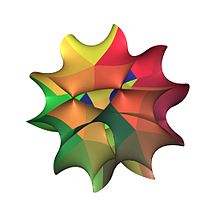
In mathematics, a Siegel modular variety or Siegel moduli space is an algebraic variety that parametrizes certain types of abelian varieties of a fixed dimension. More precisely, Siegel modular varieties are the moduli spaces of principally polarized abelian varieties of a fixed dimension. They are named after Carl Ludwig Siegel, the 20th-century German number theorist who introduced the varieties in 1943.[2][3]
Siegel modular varieties are the most basic examples of Shimura varieties.[4] Siegel modular varieties generalize moduli spaces of elliptic curves to higher dimensions and play a central role in the theory of Siegel modular forms, which generalize classical modular forms to higher dimensions.[1] They also have applications to black hole entropy and conformal field theory.[5]
- ^ a b Cite error: The named reference
surveywas invoked but never defined (see the help page). - ^ Oda, Takayuki (2014). "Intersections of Two Walls of the Gottschling Fundamental Domain of the Siegel Modular Group of Genus Two". In Heim, Bernhard; Al-Baali, Mehiddin; Rupp, Florian (eds.). Automorphic Forms, Research in Number Theory from Oman. Springer Proceedings in Mathematics & Statistics. Vol. 115. Springer. pp. 193–221. doi:10.1007/978-3-319-11352-4_15. ISBN 978-3-319-11352-4.
- ^ Siegel, Carl Ludwig (1943). "Symplectic Geometry". American Journal of Mathematics. 65 (1). The Johns Hopkins University Press: 1–86. doi:10.2307/2371774. JSTOR 2371774.
- ^ Milne, James S. (2005). "Introduction to Shimura Varieties" (PDF). In Arthur, James; Ellwood, David; Kottwitz, Robert (eds.). Harmonic Analysis, the Trace Formula, and Shimura Varieties. Clay Mathematics Proceedings. Vol. 4. American mathematical Society and Clay Mathematics Institute. pp. 265–378. ISBN 978-0-8218-3844-0.
- ^ Cite error: The named reference
entropywas invoked but never defined (see the help page).